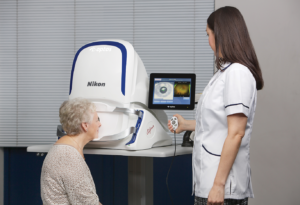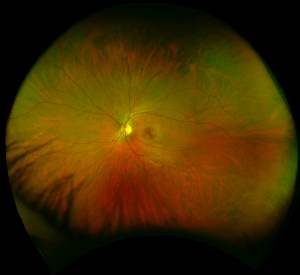Optos California

We have recently incorporated ultra-widefield retinal imaging into all comprehensive eye examinations. This revolutionary technology elevates the quality and thoroughness of each and every annual examination that we perform. Ultra-widefield retinal technology using the new Optos California technology allows our doctors to evaluate 200 degrees through a non-dilated pupil. Widefield imaging devices have been around for many years. Older versions of the imaging machines were limited in resolution, ease of use, and quality of scans. The new Optos California provides retinal images that meet or exceed the detail that can be seen with any other device or procedure. This new technology has been so impressive that it is now used in many retinal specialty clinics and in numerous clinical trials.
Ultra-widefield retinal imaging allows us to more easily detect eye health problems such as: glaucoma, diabetic retinopathy, high blood pressure, cholesterol buildup within the arteries, glaucoma, macular degeneration, retinal tears, retinal detachments, leukemia, melanoma which can originate in the eye, cancer which has spread to the eye from other places in the body, retinal thinning which increase the risk of retinal tears and detachments, and a host of other problems.

This technology is valuable not only for adults, but for children as well. The original Optos technology was designed after a 5 year-old boy lost his vision in one eye due to a retinal detachment. Today’s technology would have uncovered the thin portion of his retina which predisposed him to have the retinal detachment. Another example is an 18 year old patient who presented for a routine examination and was found to have melanoma in one of her eyes. This technology is even used to screen for retinal problems in premature infants.
We understand that dilation is not always practical for patients as it takes several hours for their eyes to return to normal, but our retinal examinations are significantly limited when eyes are not dilated. The new Optos obtains a clear image through a non-dilated pupil. Our doctors and our patients will be able to rest assured that a disease is not being missed due to non-dilation. Furthermore, it is very challenging to view the retina in children due to apprehension, light sensitivity and a limited attention span. The Optos California captures an image in ½ of a second—allowing most children to be imaged.
Simply put, wide-field retinal allows us to catch and treat problems before they become vision- or life-threatening.
Please visit the Optos website to learn more:

This is an ultra-widefield retinal image taken with the Optos California.